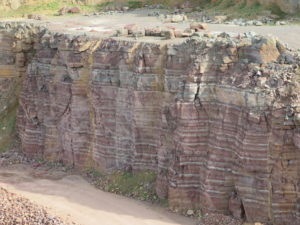As this is my first post, I should probably give a small introduction of myself and the project that I am working on. I am Annique van der Boon, and I am working on establishing reversal rates during the Devonian and Carboniferous, within the context of the DEEP project.
Last month, I went to Bremen, to the first meeting of IGCP 652 – Reading geologic time in Paleozoic sedimentary rocks . The IGCP projects are UNESCO initiatives that gather participants from all over the world to study a certain topic. IGCP 652 brings together astrochronology, radiometric dating and biostratigraphy, in order to improve the timescale of the Paleozoic, focusing on the Ordovician to Devonian.
The meeting started with a short course on astronomical tuning. For three days we followed lectures about Milankovitch cycles and how they are expressed in sedimentary successions. We then learned to use Astrochron software , in which you can analyse records with geological data for astronomical forcing. During the last day, we got to work with our own data. I had two sets of data from different sections, one of which did not show any cyclicity in the field, which was confirmed by using Astrochron. The other one looked very cyclic in the field, and this one showed a very good match with one of the Milankovitch cycles, so I was very excited, as I had not done this kind of analysis before.
After the course, my favourite part of the meeting started: we went to look at some outcrops! Over the course of three days, we saw a lot of amazing geology in the Rhenish Massif. We went to quarries that exposed Devonian sediments and volcanic rocks, Permian salts, and Triassic oolites and stromatolites. Especially the Effenberg quarry was impressive. I also made a short video to shows some of the outcrops and explain the IGCP 652 project, which you can see below.
The last part of the meeting consisted of many great talks and posters (mostly) about Paleozoic sedimentary rocks. It was great to meet so many people that also work on the Devonian, and we established a lot of new collaborations during the meeting.
I am interested to find more Devonian and Carboniferous sedimentary records to do magnetostratigraphy on. We are looking for sediments that possibly hold a primary Devonian and Carboniferous magnetisation, and thus show low thermal maturity (indicated for example by conodont alteration index values of <3) and no signs of chemical alteration. If you happen to know any, please get in touch!


Leave a Reply